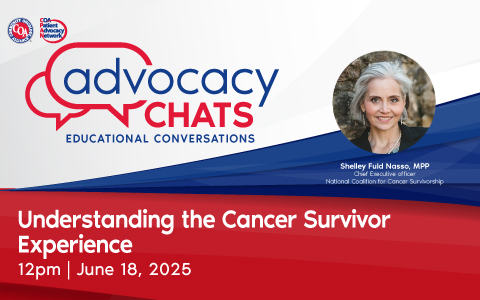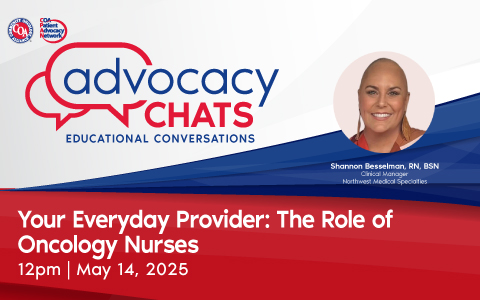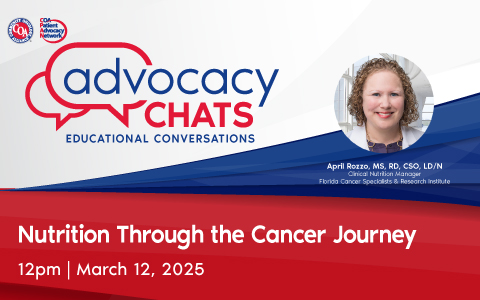The Role of Pharmacists in Community Oncology
October was National Pharmacist Month, so it was fitting that this Advocacy Chat examined the role pharmacists play as part of the cancer care team. Oncology pharmacists interact with and advocate for patients on a daily basis, serving as important points of contact for patients and their families. The Community Oncology Alliance’s (COA’s) Director of Patient Advocacy and Education, Rose Gerber, M.S., was joined by two prominent oncology pharmacists, COA’s Director of Clinical Initiatives, Judy Alberto, MHA, RPh, BCOP, and Chief Strategy Officer at Hematology-Oncology Associates of Central NY (HOACNY), Jonas Congelli, RPh, for this important conversation. Both Judy and Jonas have extensive oncology pharmacy experience and brought their expertise to the table as they highlighted the oncology pharmacist’s role in community oncology.
When preparing and dispensing drugs, oncology pharmacists employ special storage and handling equipment, coordinate transport and delivery, and work with physicians to ensure patients receive the most effective treatment and experience minimal side effects. Pharmacists do much more than just dispense drugs, especially in specialties like oncology. In addition to preparing treatments, each day oncology pharmacists also serve as counselors to the patients receiving treatment, discuss possible side effects, handle insurance issues, help find financial assistance, and are important patient advocates pushing for lower prescription drug costs.
What Does a Pharmacist in a Community Oncology Practice Actually Do?
When Jonas Congelli started at HOACNY in the late 80’s, he was the first pharmacist ever on staff at the practice, and his role was yet to be defined. Much of what he did had previously been handled by the nursing staff. His presence freed the nursing staff to focus on patient care and they no longer had to worry about mixing medications and drug calculations. A pharmacist was now able to perform those duties. By involving a pharmacist, another layer of safety was added in the handling and dispensing of highly hazardous drugs. In addition to patient and staff safety, pharmacists can create standards, procedures, and protocols that improve efficiency. Over the years, the pharmacists’ role has often grown to include purchasing. This involvement has brought about cost controls for the patient, as well as the practice.
As treatment has evolved from mostly infused drugs to oral drugs, the pharmacist is integral to building and growing, dispensing for both the treatment and convenience of patients. HOACNY’s pharmacy team grew from one pharmacist to five pharmacists and 10 pharmacy technicians who have provided the level of service and care characteristic of community oncology practices. It became the standard that community oncology practices have a pharmacist, and often more than one, on staff who have added to the services offered to patients.
How COA Supports Practice Clinical Initiatives
As a board-certified oncology pharmacist, Judy Alberto provides support to improve clinical care and bridges the gap between clinical initiatives and the clinical staff, particularly the pharmacy staff. She looks at a pharmacy’s needs to determine how to best support the teams in each practice in order to improve overall patient outcomes. The primary focus is on medication management and how to improve the patient experience and outcome.
Part of Judy’s role includes managing COA’s Community Oncology Pharmacy Association (COPA). This organization is open to pharmacists, pharmacy technicians, and other community oncology practice staff with an interest in, or who work with, the practice pharmacy.
What Mail-Order Pharmacies Mean to Patients
Mail-order pharmacies can provide cancer drugs to patients and often offer auto-renew programs which can be convenient but are not as beneficial as they might have seemed at first encounter. The face-to-face interaction with the pharmacist in a community oncology setting is a benefit that mail-order pharmacies cannot provide even though it is a critical safety component.
Oral drugs have grown to represent about 40 percent of all cancer drug treatment making the involvement of the pharmacist more important than ever. The face-to-face interaction has allowed for education and counseling to ensure compliance, answer questions, and provide support.
Mail-order pharmacies have been an excellent management resource for patients on medication for chronic conditions, such as cholesterol, blood pressure, and other conditions where things were not likely to change much during the treatment. Cancer treatment frequently consists of an oral medication or oral plus infused medications. In these cases, it has been vital that patients were kept on their therapies as intended. Compliance and timing thus become critical. When forced to use a mail-order pharmacy for such time-sensitive treatment, fragmentation of care can become an issue. The face-to-face interaction with the pharmacist can keep patients on schedule, enabling care to happen as prescribed, and giving patients the greatest opportunity for the best outcome.
Treatment involving a community oncology pharmacist gives the patient access to what they need. First and foremost, the patient has access to the pharmacist and the pharmacist to the patient. Additionally, there can be immediate access to the patient’s physician, full medical records, and pathology and lab reports. If an issue were to arise, the pharmacist has full and immediate access to everything he/she needs in order to make an informed treatment modification decision.
In contrast, a retail or mail-order pharmacist has access to the medication prescription and maybe some medication history but often has little other information. They are dispensing highly toxic and extraordinarily complex medications in the absence of what could be critical information. This is probably not the best way to care for patients. A step-back view of this situation may cause a change in basic assumptions on how to better care for patients by being closer to the patients and having the pharmacist embedded into the care team.
Management of the Medication Status and Chain of Custody
One of the consequences of medications provided by mail-order pharmacies is lack of proper handling. There is great convenience in going to the mailbox and finding the medication there. The problem is that there is no way to know what temperature and moisture fluctuations to which that medication may have been subjected. There is no way to know if the efficacy of that medication may have been compromised. This compromise has quality of care and cost implications.
It is common for medication changes or dose changes to be made as the oncologist refines patient treatment. Mail-order pharmacies will often fill a prescription in a 30, 60, or 90-day supply. If the physician makes a change, expensive medication is wasted. Again, this unused medication generates waste that is not being tracked but certainly has profound costs as the now unusable drugs accumulate. Some studies have estimated that as much as 20-50 percent of the medication provided through the mail-order system is wasted with an overall cost to the health care systems and to patients.
Community oncology pharmacists are able to limit an initial medication quantity to avoid waste due to medication or dose changes. This has helped to control costs to both patients and the health care system. The face-to-face nature of community oncology care also avoids the chain of custody issues that arise with medication that must be refrigerated or those that cannot sustain the high temperatures that may occur in the summer months. By keeping the chain of custody between the patient and the pharmacist more direct, the integrity of medications has been protected.
What Patients Should Discuss with Their Community Oncology Pharmacists
Patients should bring to their pharmacist any questions related to side effects, when to take medications, and other relevant issues. The pharmacist is able to anticipate what questions the patient may have, as well as to follow up three to five days after the patient begins taking a drug to make certain the patient is compliant and not having any unanticipated problems. The established regimens for oral therapies are deliberately in alignment with the same management programs as infused medications. It is important to follow patients receiving oral therapy to determine that they are receiving the care as intended and when intended.
CPAN Advocacy Chats are regular virtual 30-minute educational conversations about cancer advocacy and policy with a guest speaker invited to discuss issues important to patients and advocates. Summaries of previous Advocacy Chats are available on the CPAN website.
Past Advocacy Chats





